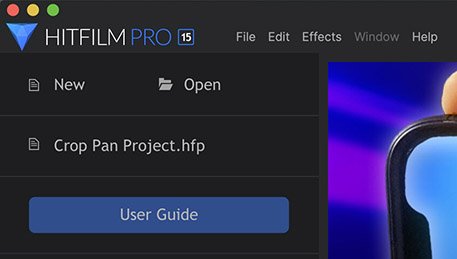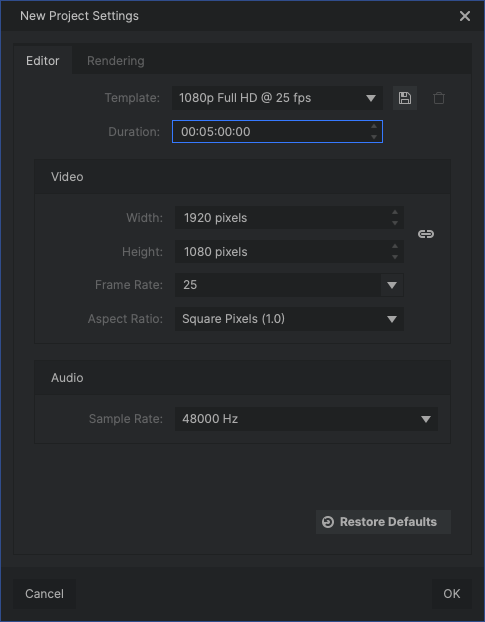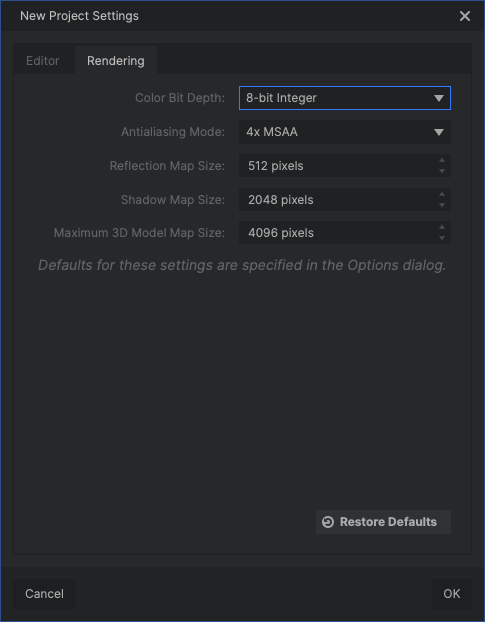After starting HitFilm Pro you are presented with the Home screen. From here you can quickly access your recently saved projects, or create a new project.

Clicking the New button will open the New Project Settings dialog, where you set up your initial project settings:

Template
- Template: Templates are provided for common video formats up to 8k resolution.
Save: The Save icon to the right of the templates menu allows you to save your current settings as a new template, for future access.
- Duration:
Video
It is advisable to be familiar with the formatting details of the footage you will be editing, before you begin your project. If you know the resolution, frame rate, and aspect ratio of your footage, enter that information here. If you don’t know these settings, then don’t worry. You can skip them for now, and HitFilm can adjust the settings for you later, to match the video files you import.
- Width: The width in pixels you want your project to use. The maximum supported resolution will depend on your hardware. See Resolution below for full details.
- Height: The height in pixels you want your project to use. The maximum supported resolution will depend on your hardware. See Resolution below for full details.
- Frame Rate: The number of frames per second that you want your project to use. This should be the same frame rate that you wish to export your project to. In most cases, it will also be the same frame rate as your imported video.
- Aspect Ratio: The pixel aspect ratio that you want your project to use. This should almost always be set to square. Some cameras create anamorphic video, which is compressed horizontally when recorded, and requires the pixels to be stretched horizontally when displayed. Even when you plan to import anamorphic video files, it is usually best to set up your project with a square pixel aspect ratio. Any anamorphic video you import will then be conformed to standard square pixels, so it can be viewed correctly, without distortion, in any context.
Supported Project Resolutions
The project resolution which HitFilm will support is dependent on the amount of video RAM on your GPU. HitFilm Express supports resolutions up to 4K DCI (4096 × 2160). HitFilm Pro supports resolutions up to 8K.
- Less than 1GB of video RAM supports resolutions up to 1920×1088
- 1GB of RAM up to 4GB will support resolutions up to 4096 × 4096
- 4GB or more of video RAM will support resolutions up to 8192 × 8192.
Audio
Select the sample rate that you wish to use for your project. In general, this should be the same sample rate used by your audio files. If you will be importing audio files with multiple sample rates, your project should use the Sample rate at which you wish to export.
Rendering

The Rendering tab stores settings related to the quality at which your project is rendered. In general, higher settings create higher quality results, at the expense of slower performance. You may want to adjust some of these settings periodically while working on a project, using lower settings while working to increase productivity, then switching to higher settings to evaluate quality, or for your final export. You can also set default values for these settings in the General tab of the HitFilm Options (Preferences on Mac).
- Color Bit Depth: Higher bit depth creates higher fidelity images but will increase rendering times, especially on less powerful hardware.
- Antialiasing Mode: Antialiasing is used to create perceptibly higher quality edge detail. HitFilm supports multiple antialiasing types depending on the capabilities of your hardware. Higher numbers can give higher quality results, and may increase processing times.
- Reflection Map Size: The quality of 3D model reflections can be controlled using the resolution of the reflection maps. Larger reflection maps will create higher quality reflections at the cost of performance. The default setting of 512 pixels looks good in most circumstances other than close-ups.
- Shadow Map Size: The quality of shadows can be controlled using the resolution of the shadow maps. Larger shadow maps will create smoother edges on shadows, at the cost of performance.
- Maximum 3D Model Map Size: The quality of 3D model textures is dependent on the resolution of the texture maps. Larger texture maps will create higher quality reflections, but will also impact performance. Some hardware may not be capable of handling very high resolution maps.
Additional details about these render settings are available on the Render Options page of this manual.
You can return and edit your Project settings at any time through the File menu, by clicking File > Project Settings.
